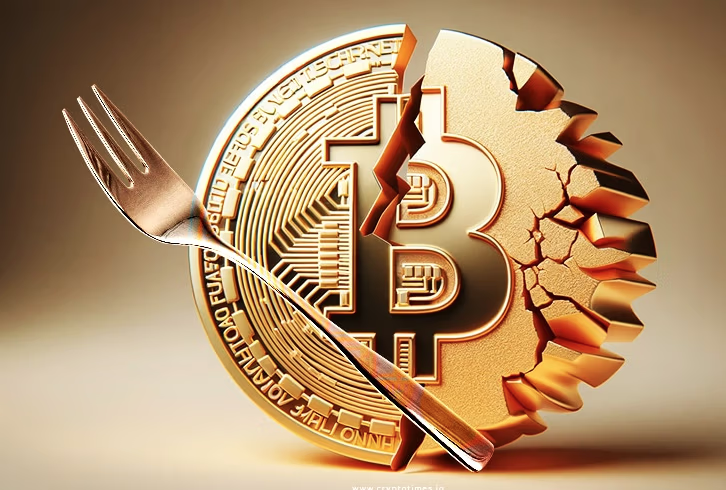
In the ever-evolving world of cryptocurrencies, terms like “fork” often come up in discussions about blockchain technology. But what exactly is a Bitcoin fork, and why is it such a pivotal concept in the crypto world? If you’ve been hearing about forks and wondering how they impact Bitcoin (BTC), you’re not alone. In this article, we’ll break down what a Bitcoin fork is, how it works, and why it matters to you as a crypto enthusiast or investor.
What Is a Fork in Cryptocurrency?
At its core, a “fork” refers to a change or update in the protocol of a blockchain network. Think of it as a software update for the blockchain—one that could lead to two diverging paths or versions of the same blockchain. When it comes to Bitcoin, this fork could result in a new cryptocurrency being created, or it might simply enhance the functionality of the existing network.
But why would anyone want to fork a blockchain? The answer lies in innovation and decentralization. Forks allow the community to propose and implement changes to the network without relying on a central authority. It’s like crowdsourcing the development of the blockchain, allowing different parts of the network to decide how it should evolve.
Types of Bitcoin Forks
When it comes to Bitcoin forks, there are two primary types to be aware of: soft forks and hard forks. Let’s dive into both:
Advertisement
Join Gemini today and get $15 in free Bitcoin when you trade with an easy, secure and U.S.-regulated crypto exchange you can trust. Offer valid for U.S. residents only; crypto investments are risky.
1. Soft Forks: Small Changes, Big Impact
A soft fork is a backward-compatible change to the Bitcoin protocol. In simpler terms, a soft fork is a change that doesn’t break compatibility with older versions of the software. If you have the old version of the software running, you can still interact with nodes that have adopted the new version, as long as the changes are within certain limits.
Examples of soft forks include Bitcoin’s SegWit (Segregated Witness) upgrade. This upgrade was introduced in 2017 to help with transaction speed and scalability. SegWit effectively altered the way data was stored in Bitcoin transactions, improving efficiency without requiring a complete overhaul of the entire blockchain system. The change made Bitcoin more scalable and enabled other features like the Lightning Network, which facilitates faster, cheaper transactions.
2. Hard Forks: A Split in the Blockchain
On the other hand, a hard fork is a more significant change that is not backward-compatible. In the case of a hard fork, older versions of the software can no longer communicate with the newer one. Essentially, a hard fork creates two separate blockchains—each with its own rules and cryptocurrency.
A classic example of a hard fork in the Bitcoin world is the split between Bitcoin (BTC) and Bitcoin Cash (BCH) in 2017. Bitcoin Cash was created as a result of disagreements within the Bitcoin community about the best way to scale the network. Some members wanted to increase the block size to allow for more transactions per block, while others wanted to stick with the original Bitcoin protocol. This led to a hard fork, and Bitcoin Cash was born.
Hard forks are often more controversial because they can lead to the creation of new cryptocurrencies, and in some cases, can divide the community.
Why Do Bitcoin Forks Happen?
Forks occur for a variety of reasons, but they are typically motivated by one or more of the following factors:
1. Improving Scalability and Speed
As Bitcoin becomes more popular, its blockchain has to handle more transactions. With a limited block size (1MB), Bitcoin transactions can take longer to process, especially during times of high traffic. Forks are a way to address these issues and improve scalability. By increasing the block size or optimizing transaction processes, Bitcoin forks can help reduce congestion and make transactions faster.
2. Disagreement in the Community
Forks can also arise from disagreements within the Bitcoin community. Since Bitcoin is decentralized, everyone involved in the network has a say in its direction. When two factions disagree on the best course of action—whether it’s how to scale the network or how to implement privacy features—this can lead to a hard fork, as was the case with Bitcoin Cash.
3. Innovation and Experimentation
Sometimes, forks happen because developers and miners want to experiment with new ideas or features. A fork gives the community the ability to try out new changes without disrupting the existing blockchain. It’s an opportunity to innovate and test the waters without affecting the original blockchain.
4. Security Enhancements
As the Bitcoin network grows, so does the need for improved security measures. Forks can introduce new security features to the Bitcoin protocol, such as enhanced encryption methods or new consensus algorithms. These changes can help make the network more secure and resistant to potential attacks.
Hard Forks vs Soft Forks: What’s the Big Difference?
At this point, you might be wondering: What’s the difference between a hard fork and a soft fork? Let’s quickly compare the two.
| Feature | Soft Fork | Hard Fork |
|---|---|---|
| Compatibility | Backward-compatible | Not backward-compatible |
| Blockchain Split | No | Yes |
| Impact on Cryptocurrency | Does not create a new cryptocurrency | Creates a new cryptocurrency |
| Examples | SegWit, Taproot | Bitcoin Cash, Bitcoin SV |
As you can see, the most significant difference between the two is that soft forks are backward-compatible and don’t split the blockchain, while hard forks can create entirely new cryptocurrencies and disrupt the network.
What Happens After a Fork?
When a Bitcoin fork occurs, the community and miners are typically given a choice: they can continue using the old version of the blockchain or switch to the new one. For hard forks, this often results in the creation of a new cryptocurrency that operates on a separate blockchain.
For example, after the Bitcoin Cash hard fork in 2017, those who held Bitcoin (BTC) at the time of the fork were given an equivalent amount of Bitcoin Cash (BCH) tokens on the new Bitcoin Cash blockchain. Essentially, they received “free” BCH just by holding BTC when the split happened.
However, it’s important to note that not all forks result in the creation of new cryptocurrencies. In many cases, like with soft forks, the changes are less disruptive and do not lead to the creation of new assets.
How Do Forks Impact Bitcoin and Its Price?
The effects of a Bitcoin fork on the cryptocurrency market can vary, depending on the nature of the fork and the level of support from the community. In some cases, a fork can result in a price surge, as traders and investors speculate on the new cryptocurrency that may emerge. This was evident in the case of Bitcoin Cash, which saw an increase in its price after the fork.
However, not all forks result in positive outcomes. For example, if there’s a lot of controversy or confusion surrounding a fork, it could lead to price volatility or even a decline in Bitcoin’s value. Investors often need to carefully assess the situation and decide whether the potential benefits of a fork outweigh the risks.
Conclusion: Forks Are a Vital Part of Bitcoin’s Evolution
In the world of Bitcoin and cryptocurrency, forks are not just a technical phenomenon—they are a reflection of the community’s ability to evolve and adapt to new challenges. Whether through soft forks or hard forks, Bitcoin has been able to improve its scalability, security, and functionality over time.
As the cryptocurrency landscape continues to mature, forks will likely remain a part of the process. For anyone looking to understand the ins and outs of Bitcoin, grasping the concept of a fork is essential. They represent the decentralized nature of Bitcoin, where no single entity controls the future of the network, and anyone can propose changes for the betterment of the ecosystem.
So, the next time you hear about a Bitcoin fork, you’ll know exactly what’s at stake—and why these forks are a crucial part of Bitcoin’s ongoing evolution.






